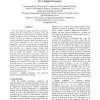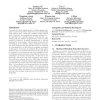60 search results - page 10 / 12 » Detecting Anomalous and Unknown Intrusions Against Programs |
WORM
2003
13 years 8 months ago
2003
This paper presents DOME, a host-based technique for detecting several general classes of malicious code in software executables. DOME uses static analysis to identify the locatio...
ACSAC
2002
IEEE
14 years 14 days ago
2002
IEEE
Malicious boot firmware is a largely unrecognized but significant security risk to our global information infrastructure. Since boot firmware executes before the operating syst...
IRI
2006
IEEE
14 years 1 months ago
2006
IEEE
With the rapidly increasing complexity of computer systems and the sophistication of hacking tools and techniques, there is a crucial need for computer forensic analysis technique...
EMSOFT
2005
Springer
14 years 1 months ago
2005
Springer
Passive monitoring or testing of complex systems and networks running in the field can provide valuable insights into their behavior in actual environments of use. In certain con...
KDD
2009
ACM
14 years 2 days ago
2009
ACM
Currently, the most significant line of defense against malware is anti-virus products which focus on authenticating valid software from a white list, blocking invalid software f...


